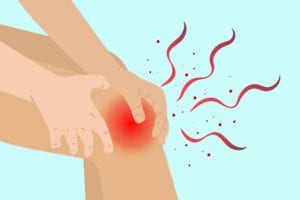Despite concerns about safety and addiction, lots of people with osteoarthritis (OA) take opioids to address their chronic pain. A recent study in Sweden, for example, revealed that one in four patients with OA had been prescribed an opioid in the previous year — despite the fact that the drugs aren’t on the list of recommended treatments except in extreme circumstances or after surgery.
Opioid medications work by attaching to opioid receptors in the brain and spinal cord and reducing the pain messages that are sent to the brain.
With lots of people with many different kinds of chronic pain, including various forms of arthritis, taking the powerful drugs, researchers at Tufts Medical Center in Boston stepped back to ask whether opioids actually work to relieve pain and improve life for people with OA.
Their results, based on an analysis of 11,402 participants across 23 randomized controlled trials, were presented at the 2019 American College of Rheumatology/Association of Rheumatology Health Professionals Annual Meeting in Atlanta.
In all of the studies included in the analysis, opioids were compared against a placebo. Here’s what the authors found:
Did opioids relieve pain and improve function? In assessments at two, four, eight, and 12 weeks, there were small but statistically significant improvements.
Did opioids help with depression or improve quality of life? Not at all.
Did people taking opioids sleep better? Yes.
Were stronger opioids more effective than weaker opioids? Surprisingly, stronger opioids demonstrated consistently worse pain relief, the researchers reported.
“’Strong opioids’ underperformance was the study’s most interesting finding, and likely due to the relationship between pain relief and tolerability of opioids based on dose,” study lead author Raveendhara R. Bannuru, MD, PhD, told the American College of Rheumatology in a press release.
In the studies, twice as many people taking strong opioids (such as morphine, oxycodone, fentanyl, and high doses of tramadol) dropped out because of side effects than those who took weak opioids (such as codeine, dihydrocodeine, and lower doses of tramadol).
“In light of this evidence, clinicians and policy makers should reconsider the utility of strong opioids in the management of OA,” says Dr. Bannuru.
The less-than-impressive results are consistent with the latest guidelines from the Osteoarthritis Research Society International (OSRI), which strongly recommends against using opioids in OA involving the knees, hips, or multiple joints.
Get Involved in Arthritis Research
If you are diagnosed with arthritis or another musculoskeletal condition, we encourage you to participate in future studies by joining CreakyJoints’ patient research registry, ArthritisPower. ArthritisPower is the first-ever patient-led, patient-centered research registry for joint, bone, and inflammatory skin conditions. Learn more and sign up here.






